Selective coverage of atrocities
Five newspapers were taken for this study: The Indian Express, The Hindu, The Times of India, Jansatta and Hindustan. Six incidents have been selected for comparative study of coverage given by the print media. Ten days of coverage given by these five newspapers from the start of the incident to the tenth day have been recorded for the research. So in total (6 cases x 10 days x 5 newspapers) 300 newspapers were studied.Data from the National Crime Records Bureau and the National Minorities Commission has also been used.
The Modi government has completed more than half of its tenure. The political situation in India seems to be more stable than before. The fiscal condition is sound and the Indian economy continues to grow. A non-Congress government at the centre is taking a lot of decisions and people’s expectations from this government are high. However, if news reports are indicative of the state of the nation, it would seem that the social fabric of the country is in upheaval. The media’s coverage gives the sense that atrocities against Dalits and the minority communities have increased under this government.
However, the voting pattern of the country and opinion surveys indicate that the common people of the country do not share the sense of turmoil as portrayed in the media reports.
So is the Government really anti-Dalit and anti-minority as the media coverage suggests? To understand this, our team has studied five newspapers and websites of several media houses, National Crime Records Bureau (NCRB) data and National Minority Commission (NMC) reports for a comparative study of the most highlighted cases against Dalits and the minorities during the incumbency of the current NDA government.
In order to study the coverage pattern of the print media and understand their news judgement while reporting on anti-Dalit and anti-minority atrocities, the two most highlighted cases under the Modi government were selected: the Dadri Akhlaq killing in UP and the Una flogging case in Gujarat. To understand whether these cases were given less or more coverage, some similar cases were identified for comparative study. For example, to compare coverage of Dadri, two similar cases - the Sanju Rathore murder case from Rampur and Gaurav’s murder case from Aligarh – were chosen. Similarly, for a comparative study of the Una Dalit flogging case, similar cases of Dalit atrocities were selected.
Statistics on Dadri, Aligarh and Rampur murder cases:
Brief about three cases:
- Akhlaq murder case, Dadri (28 September 2015, UP):A 50-year-old man, Mohammad Akhlaq, was beaten to death and his 22-year-old son severely injured in UP’s Dadri, allegedly by residents of Bisara village, after rumours spread in the area about the family storing and consuming beef.[i]
- Gaurav murder case, Aligarh (12 Nov 2015, UP):An undeclared curfew-like situation prevailed in Aligarh after the death of a 22-year-old youth in a communal clash. Things worsened as a reported incident of eve-teasing on ‘Bhai Dooj’ in Sarai Miyan and Kailash Gali took a communal overtone, leaving a youth injured. He later succumbed to his injuries.[ii]
- Sanju Rathore murder case, Rampur (29 July 2015, UP):Cattle belonging to a member of the majority community were grazing in the field of a member of the minority community leading to a scuffle between the members of the two communities. Two villagers, Jitendra Singh and Raju Singh, sustained severe injuries in the fight. Later in the evening, the members of the minority community opened fire at the religious site of the other community. Amidst the firing, Sanju Rathore, 15, sustained bullet injuries on his neck and died on the way to hospital.[iii]
The cases were selected for comparative study as all these three incidents took place in Uttar Pradesh in the same time period (i.e. within a period of six months) and all were murders that had escalated into community clashes. The chart below shows the statistics of media coverage of these cases:
|
Case 1: 28 Sept 2015: Dadri-Akhlaq-Bisara-UP, Date: 29 Sept to 8 Oct 2015 |
||||
|
Newspaper |
No. of news items |
Front page |
Pages used |
Pages |
|
Indian Express |
77 |
14 |
9 |
1,2,3,4,5,6,7,14,15 |
|
The Hindu |
31 |
8 |
5 |
1,10,11,12,14 |
|
TOI |
68 |
8 |
10 |
1,8,9,10,11,12,13,14,15,17 |
|
Jansatta |
33 |
7 |
7 |
1,3,4,5,6,8,9 |
|
Hindustan |
24 |
7 |
4 |
1,6,7,10 |

|
Case 2: 12 Nov 15: Gaurav killed by Muslims over firecracker in Aligarh, 13 Nov 15 to 22 Nov 15 |
||||
|
Newspaper |
No. of news items |
Front page |
Pages used |
Pages |
|
Indian Express |
1 |
0 |
1 |
Page 13 |
|
The Hindu |
0 |
0 |
0 |
0 |
|
TOI |
1 |
0 |
1 |
Page 11 |
|
Jansatta |
0 |
0 |
0 |
0 |
|
Hindustan |
2 |
0 |
2 |
(14nov) Page 7, (15 nov) Page 16 |
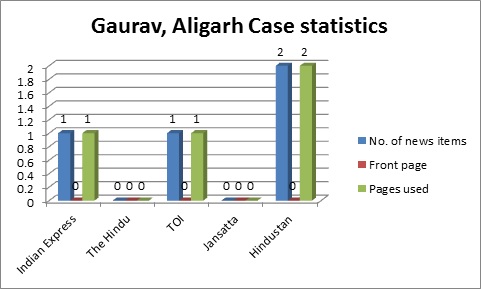
|
Case 3: 29 July 2015: Sanju Rathore-15 year old boy case: Rampur, Kupgaon village, 30 July to 8 Aug 15 |
||||
|
Newspaper |
No. of news items |
Front page |
Pages used |
Pages |
|
Indian Express |
0 |
0 |
0 |
0 |
|
The Hindu |
1 |
0 |
1 |
Page 11 |
|
TOI |
0 |
0 |
0 |
0 |
|
Jansatta |
0 |
0 |
0 |
0 |
|
Hindustan |
0 |
0 |
0 |
0 |
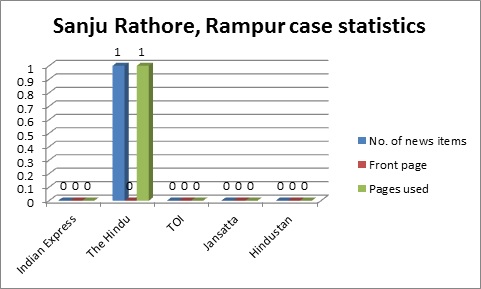
The statistics show that the media has given more coverage to the case in which a Muslim man was killed than to the other two cases in which Hindus were killed. A murder is a murder and it should be reported with all seriousness but the media has shown discrimination in these three murder cases. Moreover, instead of blaming the state government for law and order, the media and civil societies mainly blamed the central government for the Akhlaq murder case for some reason.
Statistics on Una, Muzaffarpur and Godhra Dalit cases:
- Una, Gujarat, Dalit Case (11 July 2016, Gujarat):Dalit youths were beaten up by a group of people for skinning a cow on 11 July, 2016 in Mota Samadhiyala village, Unataluka, Gir Somnath District, Gujarat. One of those arrested was a Muslim teenage boy from UNA (Indian Express, 20 July 2016)[iv]. It led to massive protests in Gujarat and several opposition political party leaders visited the site and blamed the BJP for supporting cow vigilantism.
- Muzaffarpur, Bihar, Dalit Case (20 July, 2016):Two Dalit youths were beaten and urinated upon by some men allegedly for stealing a motorcycle. The incident took place at Babutola under Paru block in Muzaffarpur district. The two were locked in a room and later beaten up on the charge of stealing a motorcycle. The culprit's nephew also urinated on the victims, the FIR said. The mother of the victim said her husband was also attacked and humiliated when he went to rescue the Dalit youth.[v]
- Godhra, Gujarat, Dalit case (26 July, 2016): A 20-year-old Dalit man, Akshay Chauhan, a resident of Baharpura area in Godhra, went to Phool Saiyad Society to meet a girl with whom he was in a relationship. The incident occurred when the boy was sitting on the terrace of the girl's house and some other boys came to the girl's house on motorbikes. They began shouting at Akshay and asked him to come down. The girl's family members too were present in the house but the accused broke open the door and came in. The accused then began abusing Akshay and made disparaging remarks about his caste, the police said. They were angry with Akshay as he kept visiting their area and spent time with the girl. The group thrashed Akshay and then dragged him out of the girl's house. He was beaten up again and then the accused took him to a field nearby, where they thrashed him again. Akshay told the police that the assailants thrashed him with belts and sticks. The police said that some of the accused took out a sword and attacked him. He sustained injuries on his face and back but managed to flee from the spot and reached his house. Akshay also registered a case of loot against the accused for taking away Rs 3,000 and a mobile phone from him.[vi]
The reason behind selecting these cases for a comparative study is that these incidents took place against the Dalit community in July, 2016. Two of these cases are from Gujarat and one is from Bihar. Out of the two Gujarat cases, in one case only one community member was involved in crime and in the other both community members were involved in crime but it was the majority community that was mostly highlighted by the mainstream print media. Similarly, the Bihar case was also equally heinous and was selected for the study.
The statistics of coverage of all three cases is as below:
|
11 July 16: Una, Gujarat case, 12 July to 21 July |
||||
|
Newspaper |
No. of news items |
Front page |
Pages used |
Pages |
|
Indian Express |
12 |
3 |
4 |
1,2,8,11 |
|
The Hindu |
10 |
3 |
4 |
1,9,10,13 |
|
TOI |
7 |
2 |
5 |
1,10,11,17,18 |
|
Jansatta |
5 |
1 |
4 |
1,4,6,8 |
|
Hindustan |
4 |
1 |
2 |
1,9 |
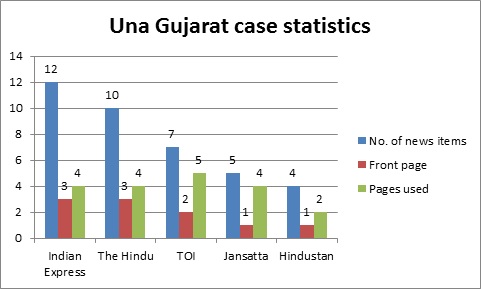
|
20 July 2016-Dalit thrashed, urinated upon (Muzaffarpur-Babutola) Bihar, 21 July to 30 July |
||||
|
Newspaper |
No. of news items |
Front page |
Pages used |
Pages |
|
Indian Express |
0 |
0 |
0 |
0 |
|
The Hindu |
1 |
0 |
1 |
Page 9 |
|
TOI |
0 |
0 |
0 |
0 |
|
Jansatta |
1 |
0 |
1 |
Page 9 (24 july) |
|
Hindustan |
0 |
0 |
0 |
0 |
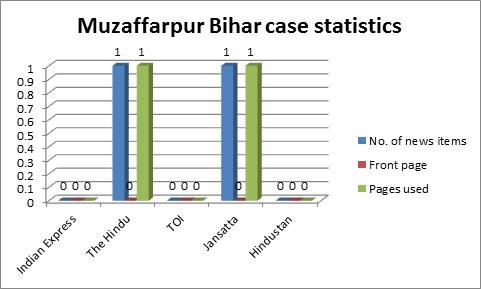
|
26 July 2016 Dalit beaten (Godhra, Gujarat), 27 July to 5 Aug |
||||
|
Newspaper |
No. of news items |
Front page |
Pages used |
Pages |
|
Indian Express |
0 |
0 |
0 |
0 |
|
The Hindu |
0 |
0 |
0 |
0 |
|
TOI |
0 |
0 |
0 |
0 |
|
Jansatta |
0 |
0 |
0 |
0 |
|
Hindustan |
0 |
0 |
0 |
0 |
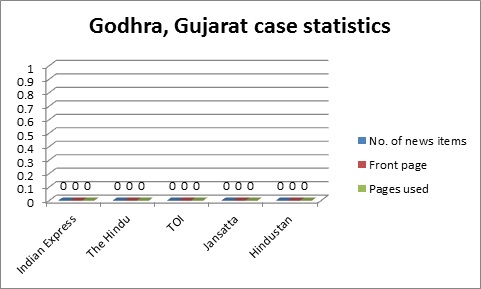
The facts suggest that all these three cases were heinous crimes against Dalits but the kind of coverage they got is very different. Similarly, the Una case has got more front page coverage while the other two have got zero front page coverage.
In these three cases also, the media have highlighted the Una case (which happened in BJP-ruled Gujarat) more than the Bihar case. Similarly, when Muslim men have beaten a Dalit boy in Gujarat (a BJP-ruled state), the media did not pick up that story.
But, only on the basis of these cases, it cannot be said that atrocities against Dalits or the minorities have increased or decreased under this government. To understand this aspect, more reports have been brought under the ambit of the study and the following data emerged after an analysis of government reports:
Study of National Crime Records Bureau (NCRB) and National Commission for Minorities (NCM) reports:
After researching the above cases, the law and order situation of the minorities and the Dalits under the present government was not clear. So, the NCRB data has been studied. The results are given below:
|
Crime incidences against SC and ST |
||
|
Year |
SC |
ST |
|
2014 |
47064 |
11451 |
|
2015 |
45003 |
10914 |
Table: NCRB data
Generally, SC and ST people are considered as Dalits, so we have taken this data into consideration and we found that the incidents of crime against SCs and STs decreased under the incumbent government. The data for the year 2016 is not available yet. The government come to power in May 2014 and from 2014 to 2015, the crime incidences against SCs and STs decreased. This does not support the mainstream print media narrative that the current government is anti-Dalit.
Complaints received from the National Commission for Minorities (NCM)[vii] reflect that crimes against the minorities decreased during the Modi government as compared to previous governments:
|
Year |
Muslim |
Christian |
Sikh |
Buddhist |
Parsi |
Jain |
Others |
Total |
|
2011-12 |
1743 |
202 |
200 |
53 |
9 |
0 |
232 |
2439 |
|
2012-13 |
1508 |
199 |
150 |
35 |
10 |
0 |
225 |
2127 |
|
2013-14 |
1988 |
187 |
186 |
45 |
13 |
8 |
211 |
2638 |
|
2014-15 |
1436 |
119 |
131 |
34 |
10 |
60 |
205 |
1995 |
|
2015-16 (Till 28 March 16) |
1422 |
145 |
121 |
32 |
11 |
49 |
175 |
1955 |
Table: National Commission for Minorities data
In this table, data of all minorities have been taken into consideration. It also reflects that in 2014-15, after the formation of the new government, crimes against the minorities and especially against the major communities, Muslims and Christians, has reduced as compared to previous governments. Hence, once again, the narrative created by the print media that the government is anti-minority is not supported by this official data either.
Conclusion:
Allowing for the fact that lynchings (Dadri) and floggings (Una) do create outrage and lend themselves to sensational coverage, the content analysis still reveals that the news coverage has been negligible in cases which should have received much more coverage. By giving disproportionate coverage to some cases, a situation could be created where a real threat to the social security of Dalits will be overlooked.
Such coverage only creates sensationalism without either resolving the cause of Dalit atrocities or bringing justice to the victims. Perhaps the Press Council of India should take note of such disproportionate coverage and come out with guidelines for media organizations to remain unbiased and objective while covering such sensitive cases.
Shubham Verma is a Research Fellow at the Public Polcy Research Centre in New Delhi. Email:Theshubhamhindi@gmail.com
[i] http://indianexpress.com/article/india/india-others/next-door-to-delhi-mob-kills-50-year-old-injures-son-over-rumours-they-ate-beef/
[iii] http://indiatoday.intoday.in/story/15-year-old-boy-dies-in-rampur-commUnal-clashes/1/455258.html
[iv] http://indianexpress.com/article/india/india-news-india/Una-SC-thrashing-muslim-boy-among-two-more-arrested-by-police-2922028/







